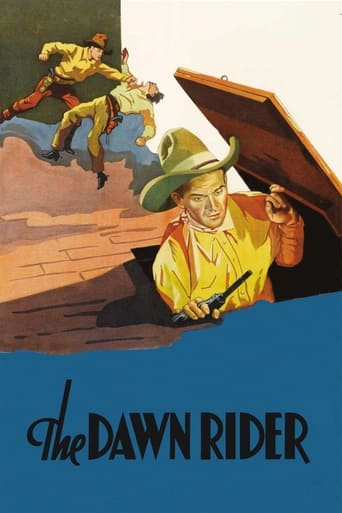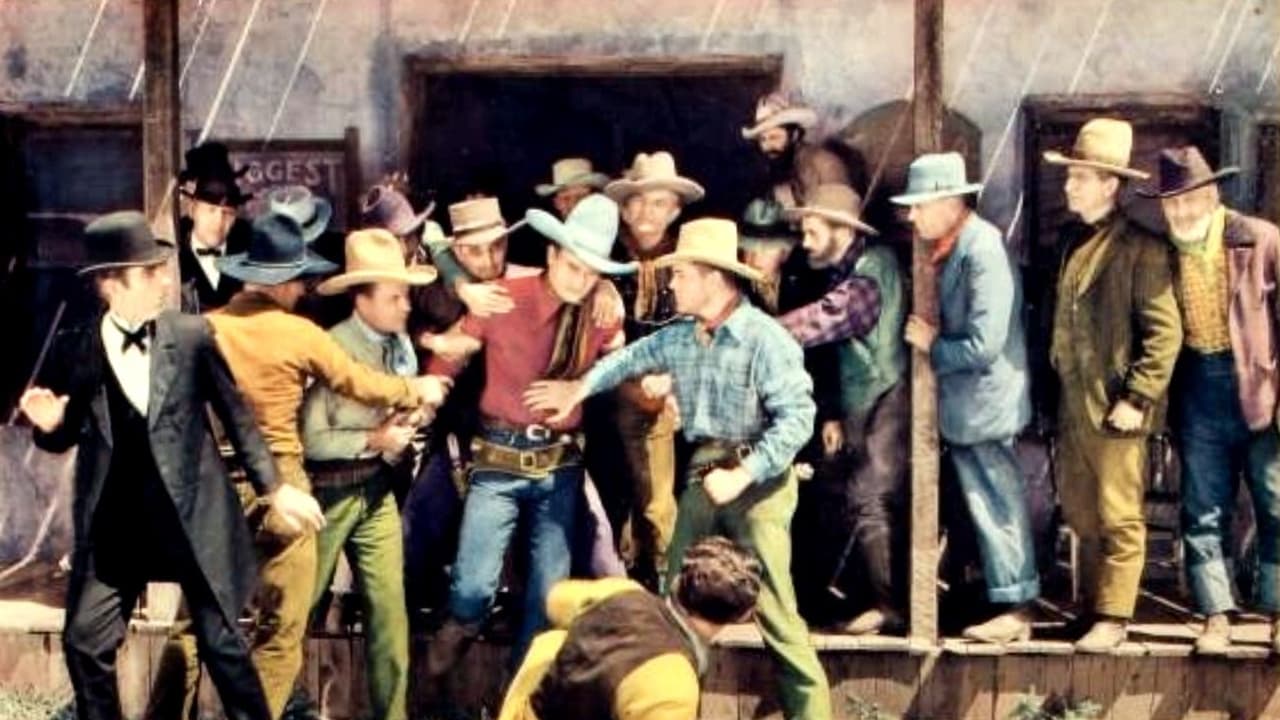Leofwine_draca
THE DAWN RIDER is another of the many B-movie westerns that John Wayne made throughout the 1930s before he really hit the big time. This one's serviceable enough, not one of the best but quite watchable. The story is okay but the action sequences are lacking at times and it's never quite as exciting as it should be. Wayne's father is bumped off at the outset and he himself is badly wounded, and he ends up falling in love with the nurse tending to him. A love triangle develops and various plot twists ensue until the expected climax. It's not bad, watchable enough for undemanding fans.
zardoz-13
John Wayne embarked on a promising acting career with director Raoul Walsh's epic wagon train spectacle "The Big Trail" (1930), one of Fox Studio's biggest and most ambitious westerns which also pioneered the widescreen process. Unfortunately, both for Wayne and what later came to be called 'Cinemascope,' audiences flocked neither to see him nor this big-budgeted oater. Consequently, Wayne languished in B-westerns, Saturday matinée serials, and supporting parts for about a decade before director John Ford rescued him from obscurity with his groundbreaking horse opera "Stagecoach" (1939) co-starring Claire Trevor and Thomas Mitchell. This top-notch revenge western not only revived the Duke's career but also ushered in a new era of maturity for westerns. Meantime, until "Stagecoach," when Wayne wasn't toiling in cheap westerns, he played bit parts in bigger movies, such as "The Deceiver" where he played a corpse, as well as "His Private Secretary" and "Baby Face," biding his time until Ford found him. Wayne took second billing to Colonel Tim McCoy in three Columbia Pictures' sagebrushers "The Range Feud," "Texas Cyclone," and "Two-Fisted Law." During this same period, Wayne toplined three sprawling Mascot Pictures serials: "The Shadow of the Eagle," "The Hurricane Express, and a French Foreign Legion version of "The Three Musketeers." Warner Brothers contracted him for a string of modest westerns, including "Ride Him, Cowboy," "The Big Stampede," "Haunted Gold,""The Telegraph Trail," "Somewhere in Sonora," and "The Man from Monterey," but Jack Warner refused to renew his contract. At the same time, Wayne took small parts in non-western melodramas at Warners. The Duke moved on to Monogram Pictures. He starred in 16 westerns for Lone Star Productions. Compared to his westerns at Columbia and Warners, the Lone Star oaters were primitive, poverty row productions. "The Dawn Rider" appeared near the end of the Lone Star series. In fact, "The Dawn Rider" was his penultimate appearance for Lone Star Pictures and exemplified the kind of movies that he made for director Robert N. Bradbury. By this time, Wayne was displaying some of the swaggering, masculine charm that he parlayed later into a million dollar career courtesy of John Ford."The Dawn Rider" opens as Ben McClure (Reed Howes) and a town undertaker named Bates discuss the sheer lack of excitement in town. Bates shakes his head and observes morosely, "Oh, this town is too healthy. If something don't happen soon, I'll have to vamoose." Suddenly, they witness a scuffle between two cowpokes on the main street. McClure intervenes, brandishes his six-shooter, and forces the man who started the fight to dance in front of a crowd of folks by shooting at the fellow's feet. This bullet ballet was a western staple. McClure deliberately misses the man's boots by inches. The punished cowpoke collapses in a mud hole. John Mason (John Wayne) rides into town and helps this forlorn figure out of the mud hole. Afterward, Mason challenges McClure to a fight. They tangle briefly in a fist-flying brawl that concludes with them shaking hands. The same day Mason returns home, he watches in horror as his father, Dad Mason (Joseph De Grasse) is shot to death during an Express Company hold-up. All that Mason can make out of his father's murderer is a polka dot bandana. You see, the bad man shoots Dad through a broken window. Afterward, Mason pursues the villains on horseback and blows a couple of the dastards out of their saddles with his well-aimed shots. The villains wound Mason during the fracas. Ironically, it turns out that the chief villain's sister, Alice Gordon (Marion Burns), nurses our hero back to health. Meanwhile, the chief villain, Rudd Gordon (Dennis Moore), pits our ten-gallon hero against his best friend, McClure, and tells McClure that Mason is stepping out with his girlfriend. Of course, Ben is jealous and takes all the bullets out of his gun before he realizes that Rudd has tricked him.This dusty, bare-bones horse opera features a couple of fistfights and gunfights. The scenery is as rugged as the heroes are virtuous, and the villains are nefarious. Stuntman Yakima Canutt plays an evil barkeeper who urges Rudd to kill Mason. Later, Wayne and Canutt battle it out. Watch the ring that Ben gets for Alice because it is a major plot point. Christian Slater stars in the 2012 remake that beefs up the plot considerably but sticks to the basics. The villains in the remake wear flour sacks for disguises, and Slater hero is haunted by his past in a Mexican prison. The John Wayne hero is unbesmirched by comparison. He doesn't have a U.S. Marshal (Donald Sutherland) riding after him with an arrest warrant. The remake includes the plot point about Ben's stolen ring, but the ranch that Rudd and Alice own is endanger of being repossessed. Some of the flavorful dialogue in the original screenplay credited to Robert N. Bradbury and Wellyn Totman, based on a story by Lloyd Nosler is quite good. Bradbury derives some amusing comic relief from the town's sole undertaker. None of this humor makes it into the remake that uses the F-word about ten times and contains more graphic gunfights. No, Christian Slater is no John Wayne, but the remake surpasses "The Dawn Rider."
Robert J. Maxwell
One of a series of repetitious and unpretentious Westerns that Monogram put out in the 30s. They fed the public's desire for movie fare, kept actors and crew employed during the Great Depression, and were inexpensive enough to keep the studio itself sufficiently solvent to keep grinding them out. As a kind of ancillary benefit they gave John Wayne a chance to be seasoned and develop his later screen persona.He's not really the iconic John Wayne here. He's broad shouldered, trapping, tall, and athletic but his acting is rudimentary. He hadn't yet learned to express something by repressing it. His walk is still the walk of an ordinary man, although an unusually tall one.He couldn't have gotten much help from the director, Robert Bradbury, but little could have been expected, given the constraints on time and budget. It's hard to imagine that any of the scenes required more than one or two takes. There is an elemental quality to the action. Horses never walk, they always gallop, leaving clouds of dust behind them. Almost all the punches are roundhouse rights, although one does notice a few jabs, probably the contribution of Yakima Canutt. Canutt may have been the best physical actor in the Western business but isn't prominently featured in this effort.The director, Bradbury, had made a number of earlier Westerns near Lancaster, where Wayne lived, and Wayne had a chance to see the filming taking place, alongside his childhood friend, Bradbury's son, who later became known as Bob Steele. (He was Curly in "Of Mice And Men.") The movie is mostly of historical interest, though not badly done for its purposes.
bkoganbing
If John Wayne didn't say that in The Dawn Rider he should have because the film is a tale of mixing bringing a killer to justice and getting a little payback vengeance in the process.Wayne arrives home just in time to witness his father being killed in an express company holdup. He only knows that the killer wore a polka dot neckerchief and with that clue in mind, he begins the hunt.It leads him to places he doesn't like going especially when it turns out the killer Dennis Moore is the brother of Marion Burns who is nursing the Duke back to health when he gets wounded. Added to that is a nice little romantic triangle going on between Wayne, Burns and Reed Howes who has become Wayne's best friend.Yakima Canutt plays the saloon owner and head of the gang that did the robbery and Yakima worked overtime doing the stuntwork as well. There's pretty good sequence involving a foiled robbery when Wayne takes out a gold shipment. Lots of hard riding and shooting and fighting all in a day's work for Yakima Canutt and his fellow stuntmen.I have a version that is only 54 minutes long and I suspect a lot has been cut from it as I believe originally it ran 68 minutes. I suspect the film would have been better with the director's cut.


 AD
AD


